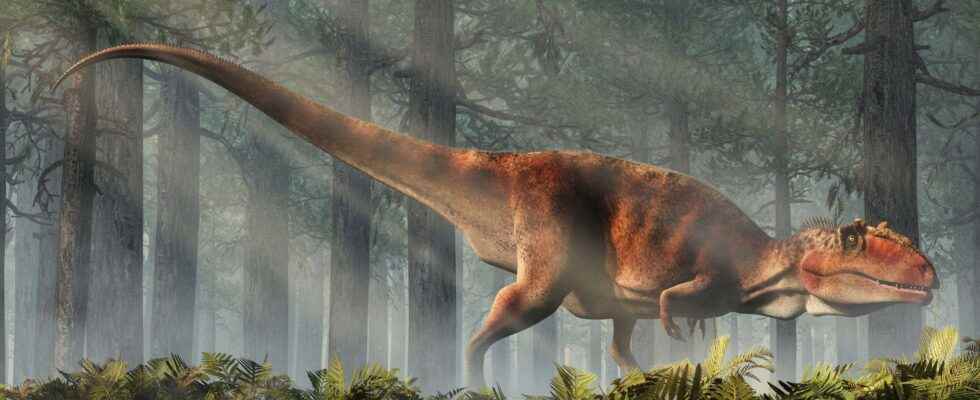For the end of the year, Futura offers you a selection of novelties that have marked the field of paleontology in 2021. Discover or rediscover the history of fossils as varied as they are astonishing!
You will also be interested
[EN VIDÉO] How the dinosaur-killer asteroid created the Amazon rainforest The flora was completely disrupted by the impact of the asteroid 66 million years ago, and flowering plants were able to proliferate.
Among the countless discoveries that have been made in the field of paleontology this year, we had to choose a dozen that have marked Futura readers as well as the scientific world. This selection brings together several types of organisms and geological periods in order to allow you to discover or remember these astonishing fossils which marked this year 2021.
A very swift dinosaur
From footprints up to date in northern Spain have made it possible to trace the trajectory of dinosaurs who lived in Cretaceous lower (-145 to -100.5 million years ago). They probably belonged to a carcharodontosaurid or a spinosaurid which are both theropods predators. According to the position of the footprints, thespecies had to move to a speed between 23.4 and 44.6 km / h, which makes it one of the non-avian dinosaurs the fastest known with Eubrontes, which was traveling at 49 km / h.
The oldest metazoans
The oldest traces of metazoan life, which are multicellular organisms with tissue, until then dated from 630 to 660 million years ago. The discovery of a vermiform structure attributed to a sponge made it possible to reassess this dating. The fossil was indeed discovered in reefs in Canada dated 890 million years ago.
Group life of dinosaurs
Non-avian dinosaurs already lived in groups made up of individuals of all ages in Jurassic lower, about 193 million years ago. A site in the south of Patagonia in Argentina has indeed yielded the fossil remains of 100 eggs and 80 remains of sauropodomorphs Mussaurus patagonicus, including individuals less than one year old, juveniles and adults.
The massive and mysterious extinction of sharks
There are 19 million years ago, 70% of sharks went extinct, twice the number of sharks that went extinct during the Cretaceous Crisis 66 million years ago. This observation was made possible thanks to the quantity and variety of shark teeth present in the fossil record over time. The causes of this mass extinction in Miocene are not yet known but it has resulted in drastically reshaping marine ecosystems.
A pterosaur with opposable thumbs
the oldest animal to have opposable thumbs was perhaps the pterosaur nicknamed “Monkeydactyl” or “monkey-finger”. This fossil was found in China and lived in the Jurassic Period, around 160 million years ago. It is the first known pterosaur to exhibit this characteristic which allowed it to be adapted to a lifestyle arboreal and probably to catch its prey.
The mammoth, this great traveler
The discovery of tusks of a woolly mammoth that lived 17,000 years ago allowed to determine what were the movements of the animal. Analysis of isotopes contained in each defense growth streak revealed that in 28 years, the mammoth walked the equivalent of almost twice around the Earth ! Isotope profiles are indeed characteristic of certain environments and therefore reflect the diet of a specimen. The woolly mammoth lived in Alaska, so it had to travel several times to very distant points in this territory to travel such a distance.
Otodus megalodon, impressive from birth
The exceptional preservation of the vertebrae of the extinct shark Otodus megalodon allowed us to estimate that at birth, the individuals were about two meters tall long, against one meter to one meter fifty in the current Carcharodon carcharias. The debate, as to the maximum size reached by O. megalodon, is moreover still in progress since the estimates attributing it the length of 18 to 20 meters were revised this year and that this species would rather have reached 14 to 15 meters, a size which however remains impressive.
A Cambrian “swimming head”
The fossil of a giant aquatic arthropod named Titanokorys sheaths was discovered in British Columbia. The species was up to 50 centimeters long and probably lived near the bottom, an environment in which these predators should not go unnoticed.
An Australian “dragon”
the pterosaur Thapunngaka shawi lived in Australia in the Lower Cretaceous and, according to its fossil remains, this reptile flying was to have a wingspan of seven meters. According to one of his discoverers, this wingspan would make him look like a “dragon” and the last shadow he cast on fish before grabbing them must have been impressive.
Everything for Tyrannosaurids
The arrival of Tyrannosaurids in North America and Asia reorganized ecosystems. Before their arrival, there were small (less than 50 kg) and medium predators (50 to 1,000 kg) of various species, while the presence of Tyrannosaurids is linked to a drastic reduction in the number of species of medium predators. This could be explained by the fact that the latter were replaced by the young Tyrannosaurids and that this group reigned supreme in these ecosystems.
Interested in what you just read?
.
fs11
